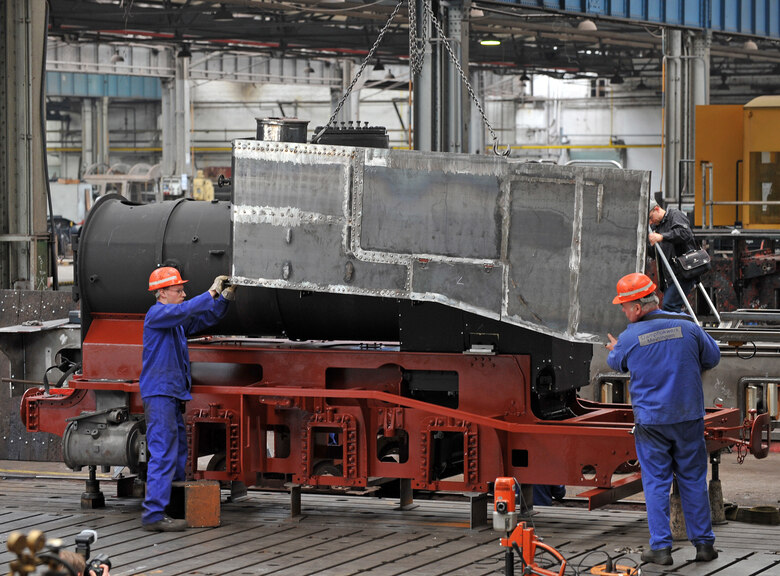The I K No. 54 narrow-gauge locomotive
The first IK train is considered a milestone in Saxon industrialisation. Over the next few pages, you'll find out all you need to know about the success, disappearance and rebirth of the legendary I K No. 54 narrow-gauge locomotive.
Did you know, for example, that it was rebuilt based exclusively on historic designs? The »Projekt Neubau« gives you an insight into the three-year reconstruction process. Follow the I K No. 54 as it gets back on track.
More information:
- Stiftung Sächsische Schmalspurbahnen Co-ordinators of the project to rebuild the I K No. 54
I K steam trains were one used on almost all narrow-gauge tracks in Saxony.
The first narrow-gauge railways in Saxony were opened between Wilkau-Hasslau and Kirchberg way back on 17 October 1881, illustrating Saxony's pioneering role in narrow-gauge railway operation at the time. By 1892, the »Sächsische Maschinenfabrik AG« had built 44 of the first narrow-gauge train, known as the Hartmann I K, and these were used to transport passengers and goods throughout Saxony until 1928.
New requirements placed on goods transportation as a result of industrialisation, however, meant stronger locomotives capable of carrying larger loads soon needed to be used. As such, some of the I Ks started being replaced by other trains in 1885.
The Deutsche Reichsbahn acquired 27 trains, classifying them as the series 99.750-752 from 1925 onwards. It ceased using them in 1928.
The I K operated on a network spanning more than 500 kilometres – Germany's largest narrow-gauge railway system at the time. But very few of these narrow-gauge routes were interconnected, meaning the IK narrow-gauge trains first had to be transported from the factory to their place of use by carrier trolleys before they could commence operation.
Despite this hindrance, the narrow-gauge railway remained as important as ever for the state of Saxony. Even when most of the narrow-gauge trans were replaced by stronger locomotives, many Saxon companies continued to use the narrow-gauge railways as factory locomotives.
The last train of this kind was dismantled at a foundry in Schmiedeberg in 1964, after a respectable 80 years of service.
On 12 January 2006, the Verein zur Förderung Sächsischer Schmalspurbahnen e.V. (VSSB) announced, as part of the opening event of the »125 years of narrow-gauge railways in Saxony« anniversary, that it was starting a project to reconstruct a Saxon I K Number 54 locomotive. No trains of this kind had existed since 1964, meaning the reconstruction had to be based exclusively on historic designs. The aim was to use this milestone of Saxon narrow-gauge railway history to preserve the remaining routes and increase awareness of Saxony's narrow-gauge railways as a cultural asset and economic factor.
A number of sponsors and companies were sought to participate in this unique project, and over 80 Saxon businesses, primarily from the metal and electrical industries, helped rebuild the I K No. 54. Assembly began in Meiningen on 15 May 2009, and the official rollout was celebrated with a summer tour on a flat-bed trailer all over Saxony, before the locomotive finally commenced its maiden trip in Radebeul on 4 July 2009.
The I K 54 operates along the remaining narrow-gauge tracks of Saxony's DAMPFBAHN-ROUTE, and at train stations across Saxony, as part of festivals and special events. It is also used to advertise Saxony as a travel destination and land of steam trains at trade fairs and events outside the state.
After more than three years of construction, the rebuilt narrow-gauge steam train I K No. 54 was officially unveiled by the Minister-President of the Free State of Saxony, Stanislaw Tillich, in Radebeul on the evening of 4 July 2009. The model train then briefly took to the tracks for the first time since its reconstruction.
Since then, the narrow-gauge locomotive has been operating and exhibited on tracks and at train stations right across Saxony. It also thrilled a number of visitors at a guest appearance in Baden-Württemberg. The Interessengemeinschaft Preßnitztalbahn e.V. (IGP) co-ordinated narrow-gauge railway operations until the summer of 2015, before this role was taken over by the Sächsisch-Oberlausitzer Eisenbahngesellschaft (SOEG) on 5 July 2015.
| Category | Fact |
|---|---|
| Manufacturer | Sächsische Maschinenfabrik, formerly Rich. Hartmann AG Chemnitz |
| No. of trains | 44 |
| Construction time | 1888-1892 |
| Category of the Royal Saxon State Railways | from 1900: I K |
| Saxon company numbers | 1-4, 6-17, 20-34, 37-42, 47-53 (total of 44 trains) |
| Reichsbahn series | 99 7501 bis 99 7527 |
| End of National Railway service | 1928 |
| Usage as a factory locomotive | until 963 |
| Dismantling of the last I K | 1964 in Saxony (I K Nr. 12) |
| Category | Fact |
|---|---|
| Model | Cn2t (three-axled wet-steam locomotive with two cylinders) |
| Gauge width | 750 mm |
| Maximum speed | 30 km/ h |
| Indexed traction | 2,1 Mp |
| Indexed output | 120 PS |
| Boiler overpressure | 12 kp/cm2 |
| Fuel store | 0,5 t |
| Length through coupling | 5280 / 5630 / 5740 mm |
| Height | 2.985mm |
| Total wheel base | 1.800 mm |
| Kerb weight | 11,9 - 13,3 t |
| Service weight | 15,3 - 16,8 t |
| Number of cylinders | 2 |
| Cylinder diameter | 240 mm |
| Water tank capacity | 1,5 m3 |
| Locomotive brake | Counterweight brake |
| Train brake | Heberlein brake |


_rdax_87s.JPG)
_rdax_87s.JPG)
_rdax_87s.jpg)
_rdax_87s.JPG)
_rdax_87s.JPG)